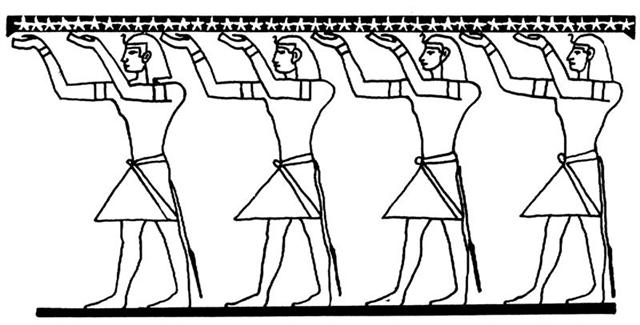Clearly side b of the C tablet is coordinated not only with the Gregorian calendar but also with the structure of the Hindu nakshatra system. The latter motivates beginning the text on side b not with January 1 but with April 17, when in rongorongo times the Aries constellation began to rise with the Sun:
The glyph type which Metoro usually said was henua (earth), but which I have decided to give a special name indicating the absence of Sun (raaraa), could here be representing - I suggest - the 'supporting prop' (ξ) where Aries was beginning. I will not abandon my idea of the raaraa typ of glyph as implying a dark time, but I could make it more precise: it is a day in the calendar where there is an 'elbow', where one 'bone' (ordered stretch of days) connects to the next. ... Fakataka swims and swims, reaching another land. She goes there and stays on the upraised reef in the freshwater pools on the reef, and there delivers her child, a boy child. She gives him the name Taetagaloa. When the baby is born a golden plover flies over and alights upon the reef. (Kua fanau lā te pepe kae lele mai te tuli oi tū mai i te papa). And so the woman thus names various parts of the child beginning with the name 'the plover' (tuli): neck (tuliulu), elbow (tulilima), knee ... ... During his descent the ancestor still possessed the quality of a water spirit, and his body, though preserving its human appearance, owing to its being that of a regenerated man, was equipped with four flexible limbs like serpents after the pattern of the arms of the Great Nummo. The ground was rapidly approaching. The ancestor was still standing, his arms in front of him and the hammer and anvil hanging across his limbs. The shock of his final impact on the earth when he came to the end of the rainbow, scattered in a cloud of dust the animals, vegetables and men disposed on the steps. When calm was restored, the smith was still on the roof, standing erect facing towards the north, his tools still in the same position. But in the shock of landing the hammer and the anvil had broken his arms and legs at the level of elbows and knees, which he did not have before. He thus acquired the joints proper to the new human form, which was to spread over the earth and to devote itself to toil ... Looking again at the 4 raaraa glyphs at the northern midsummer we can see they are not identical:
Raaraa in Cb3-17 is similar to raaraa in Cb3-19 but drawn stronger. Raaraa in Cb3-18 is similar to raaraa in Cb3-16 but its front vertical line is not stretching as high as that in Cb3-16. Such differences carry meaning. I think raaraa at left in Cb3-16 is pointing back to the previous raaraa at the beginning of side b:
Side b was probably at the basic level ruled by the Hindu nakshatra system and not by the Gregorian calendar. Possibly the 9 'feathers' around the 'bud' in Cb3-16 correspond to the 9 weeks of 'bone' between the 'joints' (yoga stars) at Cb1-1 and Cb3-16. And perhaps the 'bone' of Ardra is 'broken', because there may have been 4 supporting arms keeping the sky roof stable around the solstice. 3 + (4) + 18 = 3 weeks.
These Egyptian 'bacabs' are not drawn alike, they are individuals, they should have different proper names. For instance has number 2 from the left his head slightly lower than the rest and number 3 a smaller face. | ||||||||||||||||||||||||||||||||||||||||||||||||||||||||||||||




